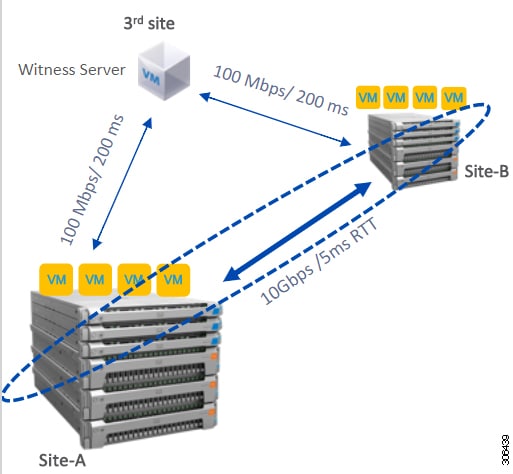Preinstallation Checklist
Network Requirements
-
10 Gbps dedicated, 5-ms Round-Trip Time (RTT) latency between the two active sites is required.
-
100 Mbps, 200 ms-RTT worst case latency for 16 kilobyte packet sizes between the active sites and witness site is required.
-
Existing fabric interconnects are supported, provided the fabric interconnects support M5 servers.
-
User VMs should be capable of vMotioning to any site, without impacting external network connectivity to these VMs.
-
Similar to regular HX Clusters, two separate IP subnets are required—Both over Stretch L2. One subnet for data traffic and one for management traffic, with the management subnet reachable from vCenter and the witness node.
-
Static IP address assigned to Witness VM, can be changed only with cluster redeployment. If DHCP server is used to define the network configuration, the IP address needs to be dedicated to Witness VM.
Network Topology

Witness Requirements
-
Configure and enable NTP on all servers.
-
An independent third witness site is required.
-
A separate witness is required for each cluster.
-
Both the main sites must have connectivity to the third witness site with a minimum bandwidth of 100 MBPS, 200 ms-RTT worst case latency for 16 kilobyte packet sizes.
-
Site must have the capability to deploy and run Open Virtualization Format (OVF) image.
Network Latency Requirements for the Witness VM
-
The HyperFlex Stretched Cluster solution requires that the Witness VM be located in a third site to ensure that a storage site failure does not affect the Witness VM.
-
The solution can support a Witness bandwidth as low as 100 Mbps, 200 ms-RTT worst case latency for 16 kilobyte packet sizes.
-
Latency to the witness impacts site failure times, and it is recommended that for larger clusters with significant load and data, to have RTT times in the order of 10ms or lower.
Fabric Interconnect and Node Requirements
-
Symmetric configuration is required across both sites.
-
There must be a minimum of two converged nodes on each site.
-
A maximum of 16 converged nodes on each site is supported. Ensure that both sites have the same number of converged nodes.
-
There must be a redundant fabric interconnect configuration on each site.
-
Converged nodes have to be M5 nodes.
-
Ensure that the Fabric Interconnect pair is of the same model in the same domain.
-
Compute-only nodes are supported.
VMware Requirements
-
VMware Enterprise Plus edition with HyperFlex Stretched Cluster is highly recommended to ensure proper failover behavior and guarantee high performance during normal operations. While it is possible to run Stretched Cluster without VMware Enterprise Plus edition, the advanced DRS features such as site affinity will not be available, negating some of the intended operational functions of Stretched Cluster.
-
Use a single vCenter for both sites.
-
The vCenter can be a VM running at the same site as the witness.
-
Nested vCenter is not supported in Stretched Cluster.
-
The vCenter must be configured independently for High Availability, as required.
UCS Manager Requirements
-
Two separate, manually synchronized fabric interconnect domains are required.
VLAN Requirements
-
IP addresses for nodes on both sites are required.
-
Stretched VLANs across both sites are required.

 Feedback
Feedback